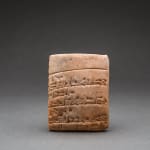Sumerian Cuneiform Tablet, 2050 BCE - 2020 BCE
Clay
2.68 x 3.43
AM.0376
Sumerian cuneiform is one of the earliest known forms of written expression. First appearing in the 4th millennium BC in what is now Iraq, it was dubbed cuneiform (‘wedge- shaped’)...
Sumerian cuneiform is one of the earliest known forms of written expression. First appearing in the 4th millennium BC in what is now Iraq, it was dubbed cuneiform (‘wedge- shaped’) because of the distinctive wedge form of the letters, created by pressing a reed stylus into wet clay. Early Sumerian writings were essentially pictograms, which became simplified in the early and mid 3rd millennium BC to a series of strokes, along with a commensurate reduction in the number of discrete signs used (from c.1500 to 600). The script system had a very long life and was used by the Sumerians as well as numerous later groups – notably the Assyrians, Elamites, Akkadians and Hittites – for around three thousand years. Certain signs and phonetic standards live on in modern languages of the Middle and Far East, but the writing system is essentially extinct. It was therefore cause for great excitement when the ‘code’ of ancient cuneiform was cracked by a group of English, French and German Assyriologists and philologists in the mid 19th century AD. This opened up a vital source of information about these ancient groups that could not have been obtained in any other way.
Cuneiform was used on monuments dedicated to heroic – and usually royal – individuals, but perhaps its most important function was that of record keeping. The palace-based society at Ur and other large urban centres was accompanied by a remarkably complex and multifaceted bureaucracy, which was run by professional administrators and a priestly class, all of whom were answerable to central court control. Most of what we know about the way the culture was run and administered comes from cuneiform tablets, which record the everyday running of the temple and palace complexes in minute detail, as in the present case. The Barakat Gallery has secured the services of Professor Lambert (University of Birmingham), a renowned expert in the decipherment and translation of cuneiform, to examine and process the information on these tablets. The following is a transcription of his analysis of this tablet:
‘Not dated, but from script and content to be assigned to the latter part of the Third Dynasty of Ur, c. 2050-2020 B.C. The text is an administrative letter, of which many were produced during this dynasty, but this is entirely exceptional for its very large, well spaced script. Most probably this is a scribal exercise in letter writing, done by a very good student, since all the signs, including some very elaborate ones, are correctly written. However in line 7 a complex sign is written in place of the simple ‘za’, and the sense of lines 10-12 is hard to follow. The beginner’s lack of experience is perhaps to blame.
Translation:
Say to Tum? : let the men measure out 1800 gur of barley, the barley of Mr Ibbi-pi, on the steppe. You measure out (the barley) for Mr Lu-Nanna on the bank of the canal. Where he hands over the barley of the palace, give him that barley also. This order will not be repeated.
A gur was a measure of capacity, over 25 litres. Barley was the normal crop in Sumer, since it tolerates the saline soil better than wheat. This is an unusual document and in fine condition.’
Cuneiform was used on monuments dedicated to heroic – and usually royal – individuals, but perhaps its most important function was that of record keeping. The palace-based society at Ur and other large urban centres was accompanied by a remarkably complex and multifaceted bureaucracy, which was run by professional administrators and a priestly class, all of whom were answerable to central court control. Most of what we know about the way the culture was run and administered comes from cuneiform tablets, which record the everyday running of the temple and palace complexes in minute detail, as in the present case. The Barakat Gallery has secured the services of Professor Lambert (University of Birmingham), a renowned expert in the decipherment and translation of cuneiform, to examine and process the information on these tablets. The following is a transcription of his analysis of this tablet:
‘Not dated, but from script and content to be assigned to the latter part of the Third Dynasty of Ur, c. 2050-2020 B.C. The text is an administrative letter, of which many were produced during this dynasty, but this is entirely exceptional for its very large, well spaced script. Most probably this is a scribal exercise in letter writing, done by a very good student, since all the signs, including some very elaborate ones, are correctly written. However in line 7 a complex sign is written in place of the simple ‘za’, and the sense of lines 10-12 is hard to follow. The beginner’s lack of experience is perhaps to blame.
Translation:
Say to Tum? : let the men measure out 1800 gur of barley, the barley of Mr Ibbi-pi, on the steppe. You measure out (the barley) for Mr Lu-Nanna on the bank of the canal. Where he hands over the barley of the palace, give him that barley also. This order will not be repeated.
A gur was a measure of capacity, over 25 litres. Barley was the normal crop in Sumer, since it tolerates the saline soil better than wheat. This is an unusual document and in fine condition.’



